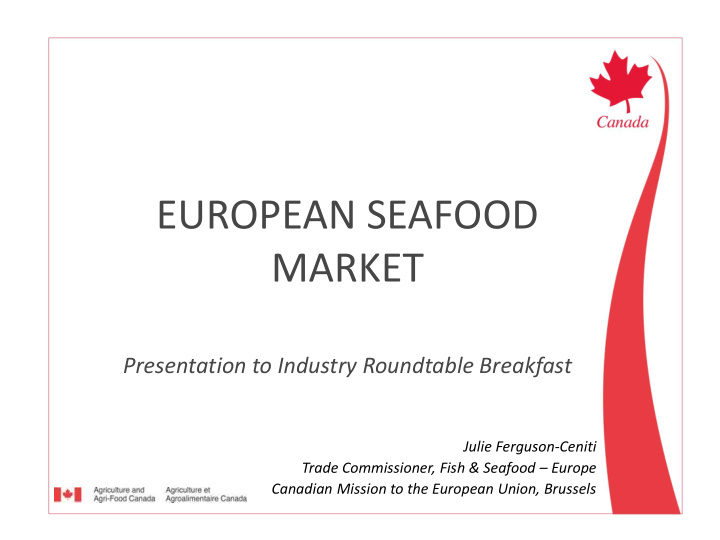



EUROPEAN SEAFOOD MARKET Presentation to Industry Roundtable Breakfast Julie Ferguson-Ceniti Trade Commissioner, Fish & Seafood – Europe Canadian Mission to the European Union, Brussels
What is the European Union? • 27 member states • 500 million people • 27% of world GDP • US$17.6 trillion • Single market, but all members have different consumer preferences • Freedom of movement of people, goods, services and capital • 17 countries share the euro
Europe is more than the EU • European Economic Area • Iceland, Norway, Switzerland and Liechtenstein • Balkans • Albania, Bosnia and Herzegovina, Croatia, Kosovo, Macedonia, Montenegro, Serbia • Eastern Europe • Russia, Ukraine, Belarus, Moldova, Georgia • EU overseas territories • Greenland
The EU shows dynamic consumption growth, but decreasing self-sufficiency Fish dependency day is July 8 Source: New Economics Foundation
Consumption in the EU • On average, each European citizen consumes 22.1 kg of seafood products per year (as of 2009) - 20% more than the global average • Total fish consumption = 10 million tonnes • EU total catch (2010) = 4 million tonnes (39% of consumption) • All but 2 countries increased consumption from 1961 to 2005 (Portugal and UK have not increased) • The FAO predicts that consumption in EU27 + Norway will rise by 9 per cent from 1989 to 2030 5
Who supplies the EU 27’s seafood? Total Imports (2012) : $23.7 billion Main Trade Partners Norway China Ecuador Iceland USA Vietnam Morrocco India Argentina Source: Eurostat
Canada’s seafood exports to EU 27 In Value and Volume since 2009 Source: Statistics Canada, CATSNET Analytics
Top 10 export markets for Canadian products in the EU27 (2012) TOP SPECIES: in CAD $000 UK: Cold-water shrimp , Canned salmon (Pink & sockeye), live lobster, Sablefish DK: Cold-water shrimp, Lobster (live & frozen), seaweeds & algae (for human consumption) FR : Scallops, lobster (in brine, frozen, live), Chum salmon (fresh/chilled), Freshwater fish fillets, smoked Herring, Seaweeds and or algae BE: Lobsters, live & in brine, Scallops, Canned Pink & Sockeye salmon, Eels, live NL: Fish fats & oils, Lobsters, live, CW shrimp, Scallops, Snow Crab DE: Lobster (live, in brine, frozen), CW shrimp, Herring fillets, Caviar, Scallops
Canadian exports to key non-EU countries TOP SPECIES: 2010 - 2012 : in CAD $ Russia: Cold-water shrimp (shell-on), hake, whitefish, 120,000 other shrimp, halibut 100,000 2010 Ukraine: Hake, cold-water 2011 shrimp, cusk & pollock, caviar 80,000 2012 Norway : Cold-water shrimp 60,000 (C&P + shell-on), scallops, lobster in brine 40,000 Iceland: Cold-water shrimp 20,000 (C&P + shell-on), other shrimp 0 Russia Ukraine Norway Iceland Switzerland Switzerland: Live lobster, shrimp & prawns, freshwater perch fillets, sockeye salmon
Tariffs are one challenge we face Tariffs on our top exports to EU Other products for which Product Specification Tariff tariffs are high / prohibitive Coldwater shrimp In shell, fresh, frozen 12% Product Tariff C&P under ATRQ 30,000 T 0% Albacore Tuna loins 18% Lobster Live 8% canned 24% Frozen in shell, whole 16% Oysters Prepared 20% In Brine (popsicles) 6% Scallops prepared 20% Scallops Live, fresh or chilled 8% Caviar 20% Salmon (pink / Airtight containers 5.5% Lobster Meat 20% sockeye) Yellowtail Flounder 18% Hake 15% Sablefish 15% Sablefish 15% Herring Fillets 15% Herring Fillets 15% Smoked salmon 13% Other tariffs: http://ec.europa.eu/taxation_customs/dds2/taric/taric_consultation.jsp?Lang=en
Other challenges • Strong Canadian dollar • Strong domestic and foreign competition • Market access issues • Continuing economic challenges • Food chain security and traceability are under fire • Animal Welfare is getting stronger and is spreading into fish and seafood products • Influence of NGOs and consumers on public perceptions, attitudes & EU policy development • Environmental issues (sustainability, carbon footprint & food miles are important)
Opportunities • Eastern European demand continues to be strong and is expected to grow, as will overall seafood consumption across the EU. • Many of our fisheries are MSC certified. Third party certification is key in some markets • Large population base, ageing and relatively wealthy • Many markets in one with multiple ethnic markets and submarkets • Strong health & wellness trend • Canada Europe Comprehensive Economic Trade Agreement (CETA)
Julie Ferguson-Ceniti Mission of Canada to the EU Brussels, Belgium Tel: +32.2.741.0715 Email: julie.ferguson-ceniti@international.gc.ca 13
Recommend
More recommend